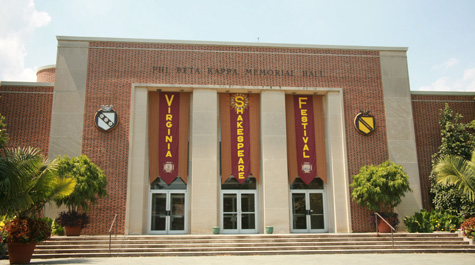W&M revamps approach to updating arts facilities
William & Mary is revamping its approach to updating the arts facilities on campus, a project the university has dubbed the “Arts Precinct” to be completed in multiple stages over several years.
Anna Martin, vice president of administration, gave an update on the arts project to members of William & Mary’s Committee on Buildings & Grounds during the recent Board of Visitors meeting.
The feasibility study completed in January 2009 proposed a $350 million project to construct an integrated art complex spanning some 300,000 square feet and housing the Muscarelle Museum of Art, departments of music, dance, theatre, visual arts and art history under one roof. Given the considerable cost of the project, we have not been able to move forward, said Martin.
While a portion of the complex can be supported by state funding – such as the academic classroom and practice facilities – a significant portion would need to be funded through private fundraising, she noted.
“We found ourselves in a place where, as Provost Halleran said, the perfect was getting in the way of the necessary,” said Martin. “It had been almost four years and we all agreed that we needed to find a way to break the project into digestible pieces in order to move forward. Otherwise, we were going to be paralyzed.
“Unfortunately, the College has had to make some difficult decisions that require us to scale back our ambitions and focus on our most immediate needs,” she said.
This summer, President Taylor Reveley, Provost Michael R. Halleran, Vice President of Finance Sam Jones and Martin visited all the arts facilities on campus. After speaking with individuals from the various departments, it became apparent that the academic departments’ needs had to be addressed first, said Martin. The initial phase of the 2009 feasibility study called for the demolition and rebuilding of the Muscarelle as the first step.
“The summer review revealed that theatre and music are in the most dire need of help from both a spacing and condition point of view,” she said. The new plan calls for those two areas to be addressed first, followed by dance and then art and art history.
The arts tradition at W&M is well established. William & Mary was the first university in the nation to include fine arts in its curriculum, doing so in 1779. In 1936, the College instituted the first “modern fine arts” department in the nation.
“We remain committed to the Arts, and our most urgent goal is giving the academic departments what they need, which is appropriate facilities,” said Halleran. “This is among our highest priorities. Every student takes at least one course in the creative or the preforming arts, which contributes richly to the liberal arts education at William & Mary.”
William & Mary will be sending out a Request for Proposal this week to have an architect conduct a more limited feasibility study, using the current programming data to examine the possibility of renovations to existing facilities as well as new construction. A key question, Martin said, will be determining if PBK, which opened in 1956 and has not undergone significant improvements, can be renovated in a way that can meet some of the academic needs. As the main performing arts complex on campus, it also houses classrooms and offices for theatre, speech and dance. William & Mary hopes to have the feasibility study completed by April 2013, said Martin, in order to include the project in the 2014-2020 Six-Year Capital Plan.
Martin said the new approach to upgrading the arts facilities will allow the university to address the most pressing issues much sooner.
“The 2009 study produced a beautiful, absolutely stunning conception – which would have been wonderful to build – but if we kept hanging on to that dream things are going to keep deteriorating for the academic departments,” said Martin. “We are committed to building the needed space as defined by the 2009 study. It will just be done in segments, over time.
“We feel confident that this action will enable us to move more quickly toward meeting the needs of our arts facilities on campus.” Skip to main content
Skip to main content

